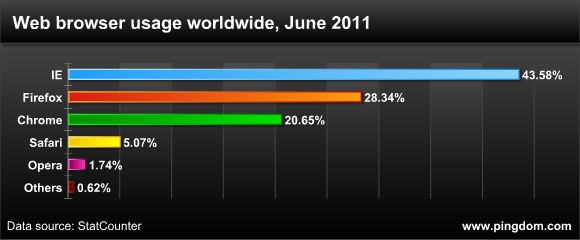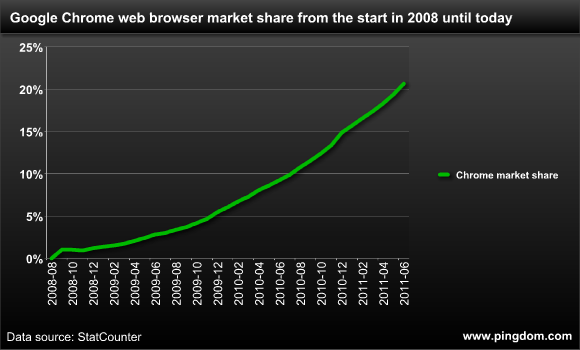 When you research web browser statistics and trends, one thing soon becomes clear: Google Chrome is on a tear. It’s gaining users, fast. In less than three years, it has claimed more than 20% of the global web browser market and is without a doubt one of Google’s biggest success stories so far.
When you research web browser statistics and trends, one thing soon becomes clear: Google Chrome is on a tear. It’s gaining users, fast. In less than three years, it has claimed more than 20% of the global web browser market and is without a doubt one of Google’s biggest success stories so far.
And the really amazing thing is that at the current rate, Chrome will overtake both Firefox and IE within a year and become the world’s most widely used web browser.
Yes, you read that right. We’ll soon explain how we got to that conclusion. (If you’re the impatient kind, scroll down to the second chart.)
The browser situation today
Today the web browser market share division worldwide looks like this:

Chrome is situated comfortably in third place. But what this chart doesn’t show is where things are heading, and that’s what we really want to investigate. Does it really stand a chance of passing Firefox and IE anytime soon?
Predicting the future of Chrome, IE and Firefox
Here below is what the past year looked like, plus the calculated, predicted growth of Chrome, Firefox and IE up to the end of 2012. We based the prediction on their average growth rate over the past six months.

Of course, reliable predictions are difficult to make for fast-moving technology like web browsers, but this is where things are currently headed. Chrome is growing like crazy while both Internet Explorer and Firefox are losing ground.
Based on the performance of the past six months:
- Chrome will pass Firefox by November 2011.
- Chrome will pass IE by June 2012.
- Chrome will have in excess of 50% market share by November 2012.
“But,” you might object, “is the trend for Chrome really that strong? I don’t really see it growing that fast.”
A closer look at the growth of Chrome so far
If you have any doubts that Chrome’s market share is not only growing, but doing so at an accelerating pace, take a look at this graph showing how Chrome has fared since its launch in 2008 until today.

The accelerating growth is clearly visible in the above graph (the increasingly sharp inclination of the curve).
Or you can just look at the numbers:
- It took 16 months for Chrome to get to 5%.
- Then half of that, eight months, for the next 5%.
- So, it took Chrome 24 months to get its first 10% market share.
- The next 10% took just 10 months.
That’s acceleration. Big time. No other web browser is showing anywhere near this kind of growth rate.
The Google advantage
If a different company than Google had released Chrome, would it have been as successful? Odds are it would at least have had a much more difficult time to get attention. Google has muscles, and above all, Google has visibility like no one else.
Online, Google of course has a huge marketing advantage over basically everyone else since it can recommend its Chrome browser on its web properties such as Google Search, YouTube, etc. Not even Facebook can compare with Google when it comes to sheer web presence, reaching over a billion users.
That said, Google has clearly built a very good and highly popular product. If people didn’t like Chrome, the browser wouldn’t be able to retain users to the extent it seems to be doing.
It will be extremely interesting to see if either Mozilla or Microsoft manages to do something to break the current trend and halt Google’s assault on the web browser market. Right now, though, things aren’t looking too good for them.
Data source: Web browser stats from StatCounter.
























